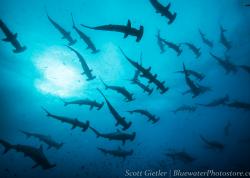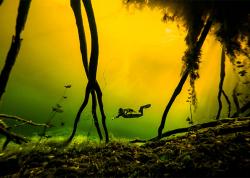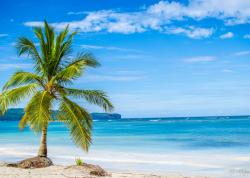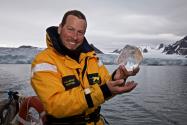Northern Exploring: Discovering the Remote Arctic
A Note from the Editor: I met Sven when I took a trip with him to Greenland for summer iceberg diving (no, the water is not really any warmer in the summer). He runs an Arctic diving tour company, Northern Explorers A/S. I have since joined him for a trip with orcas during the herring run in Northern Norway, and for two weeks iceberg diving in Greenland in April. On that last trip I got some time to sit down with him and learn a bit about what it’s like to run an Arctic diving company. -Bryan Chu, Associate Editor.

Nudibranch, photographed near my home in Norway. People at trade shows often think that Nordic waters are just cold and dark, with nothing to see. I disagree!
Nikon D300, Sea & Sea housing, 105mm macro lens, Seacam strobes. f/16, 1/200 sec, ISO 200.
Bryan: How long have you been diving and what got you into it?
Sven: I started in 1998, and at that time it was mostly in Norway. From the beginning on I was mostly interested in diving in remote areas. So once I started diving, I got my own equipment, including tanks and a compressor and everything. I was always going to remote areas, like small towns in Norway where you have no infrastructure for diving. Somehow I ended up going further and further North, and ended up in areas like Greenland and Svalbard.
Bryan: What draws you to coldwater diving or Arctic diving instead of warm water?
Sven: Once you start something you want to see more and more, and see how far you can go. I have gone pretty far, but have never felt that I was close to my limits. I am still very interested in remote areas and exploring things, especially in Greenland, as we are the only divers in this whole area (Tasiilaq, East Greenland). It’s kind of crazy that this is the biggest island in the world and it is widely unexplored underwater. So I think I have something to do for the next few decades.

Monkfish eye: Monkfish/anglerfish are perfectly camouflaged, and they know it. Therefore, they don’t move when divers approach. As these are some of the most expensive delicacies in the sea, some divers in Norway use this fact to catch these fish. Other times they are lucky, when the diver just takes a picture and lets them live.
Olympus C-7070 WZ @ 22.9mm, Reefmaster strobe. f/10, 1/80 sec, ISO 80.
Bryan: Do you do any warm water diving?
Sven: Not for Northern Explorers; when it’s warm water diving it’s on holiday. I stopped writing logbooks years ago, but out of maybe a total of 3000-5000 dives, I have done only 200 warm water dives.
Bryan: When did you start Northern Explorers?
Sven: 8 years ago.
Bryan: What was the first trip?
Sven: We started in Norway. It was quite interesting because we didn’t jump into any established tour locations. It involved a lot of scouting and, in the first three years, it was also a bit frustrating because on the one hand we wanted to earn money, but on the other hand we had to build up our products and invest in equipment. It took quite awhile until we got the space and the freedom to be relaxed about scouting new areas.
For Greenland, we sent over a container with compressors and everything before we even knew if we could make money here. So basically we put in $20,000 without knowing if we would get anything back. Now it is a bit easier because we have learned a lot. We have people who have been on tours with us before and trust in us. So, when we do scouting trips they join us for the chance to be the first to go somewhere new.

Diver meets deep-sea creature: The Norwegian Trondheimfjord is very special, as you can see deep-sea fish and other deepwater animals at recreational scuba depths. This up to 1.5m long chimaera (ghost shark) is quite common to see, often in dozens. This picture I took on a night dive. Sometimes it seems that they are interested in electronic gear; as a member of the shark/ray family they have the sense organs to feel electric impulses. So they often come close to divers to check out what going on. Luckily they are harmless and friendly.
Nikon D300, Sea & Sea housing, DX Fisheye-Nikkor 10.5mm f/2.8G lens, Sea & Sea YS-250 strobes. f/ 7.1, 1/160 sec, ISO 250.
Bryan: How do you find running a tour company vs. diving yourself?
Sven: If you would have asked me 20 years ago I could never have imagined doing this. You see documentaries on TV and think, wow, those people have supernatural powers. It’s not for normal people to go into the Arctic and dive. But it just happened one step at a time, and suddenly I was there. Sitting here in Greenland now feels so normal, but years ago it was something else…Greenland, glaciers and icebergs, something I thought I would never see.
At a certain point you have to decide what you want to do and how you want to focus. When you work as a tour operator and you spend some weeks in the Maldives, some weeks in other places, it’s different than doing more specialized things. We focus on the Arctic and it might be an advantage that we don’t have to care about other destinations.

Atlantic Salmon and sea trout in a river in Norway. They were shy, so I put my Nikon in a pool and put the camera in auto mode, taking a picture every 15 seconds. In the end they were as close as I could wish.
Nikon D300, Sea & Sea housing, DX Fisheye-Nikkor 10.5mm f/2.8G lens. f/2.8, 1/40 sec, ISO 400.
Bryan: You’ve worked with film crews, documentary makers and BBC as well…?
Sven: When you ask people, everybody seems to have worked with the BBC. But we are not one of their main corporate partners. I am not the filmmaker or the filmer. What we do is provide support for everybody who asks us. For the Arctic, it’s mainly the bigger companies who can afford projects here. We have an interesting project starting in Greenland next year, and we just finished supporting an interesting 3 year project in Norway. It was really, really interesting because we got the space to scout new dive sites and do things we cannot do on normal trips. We are not focused on just film teams, but when they do the research on who can get them to the right places with diving support in the Arctic, there are only a few companies out there who can help. So, it’s natural they sometimes come and ask us to help them.

Monkfish/anglerfish, Norway
Olympus C7070 @ 6mm, Reefmaster strobe. f/8, 1/80 sec, ISO 80.
Bryan: What’s the funniest/most interesting experience you’ve had on a coldwater dive trip?
Sven: That’s a very difficult question. At the end of each year I always have my personal highlights. Like last year in Svalbard when we had a big group of beluga whales all around our boat the whole day, and they were really playing with us more or less. I had some very interesting wildlife experiences in Svalbard. Last year was very interesting because we had one of my best trips in Svalbard…beluga whales, blue whales, walrus and other animals.
Here working in Greenland last year when we were building huts for a new camp in Sermilikfjord was one of my personal highlights, because it was different from what we normally do. I was building houses there but the scenery around was just amazing. You were working on the roof of the hut and suddenly there was a humpback whale just 150 m away.
In November we had people in the water with orca whales and they were 1-2 m away from the orca whales that came up. One guy said there was this big male orca whale looking at him face-to-face, and he thought he was filming with his GoPro, but he had actually pushed the button twice so he only got about 2 seconds where you can see the orca whale very close, and then nothing.

Iceberg aerial in East Greenland in August. Usually it is not very smart to dive in an ice bay like this. However, after observing the icebergs around for a couple of hours and seeing they were all very stable, we decided to do it. Even though this is not the time of year with the best visibility, the water looks crystal clear.
DJI FC300S drone. f/2.8, 1/2200 sec, ISO 100.
Bryan: What do you shoot underwater?
Sven: I have a Nikon D300 in a Sea & Sea housing with Seacam strobes. I don’t think I will change anything; we have some very good photographers joining the trips now, and I can just relax and enjoy their photos.
Bryan: Do you have any favourite coldwater photo subjects, especially for underwater?
Sven: I like one of the photos I’ve taken in Svalbard of walrus. It was not underwater but I was very close to them with a wide angle lens. I used a flash as it was late in the evening, around 11 pm.
There was a walrus colony nearby. For our safety and to not disturb the animals we landed the zodiac quite far away from where the animals were resting. But there were some guys in the water as well, and they obviously got curious when the saw us walking up the beach towards the colony. So they came close to check us out. However, male walrus is one of the animals I am really careful with - they often tend to be aggressive, or at least they are not in a good mood :-).

Walruses, Svalbard.
Canon 5D Mark III, EF17-40mm f/4L USM lens, flash. f/20, 1/200 s, ISO 400.
My favorite underwater shots are from Greenland in winter – clear visibility (usually 30-60 m) and icebergs. Every iceberg is like a sculpture in a way…because they are melting and breaking…when you dive on an iceberg you know no one else will ever see this iceberg. It’s a dive site that will not exist after you’ve seen it. It also makes the pictures unique, because no one else will ever take those pictures.
You never know in advance about the dive site; every season, the ice creates new shapes, structures, opportunities and challenges. Often you can really play with the light falling through the ice. Also you should be prepared to see amazing macro life, including small shrimp living on the ice, magic comb jellies and the sea angel, a swimming nudibranch.
Last winter in Greenland we dove on an iceberg in the Tasiilaq harbor. The iceberg was frozen in the sea ice and covered with snow, so we did not realize at first that it was blue ice, which has the most interesting structures. Since I did the surface support I did not have much time for diving myself. It’s always amazing diving under ice and next to an iceberg. This one was more than 30 meters deep, which you would never believe when you just see it above surface.

Blue Iceberg, Tasiilaq harbor.
Nikon D300, Sea & Sea housing, DX Fisheye-Nikkor 10.5mm f/2.8G lens. f/2.8, 1/500 sec, ISO 320.
Bryan: You run a number of different trips. Do you have a favourite, and why?
Sven: I like the trips in Norway because they are close to home. When a trip is remote, there are many many things that have to work out…for example let’s take a liveaboard in Svalbard. We have the compressors and diving equipment and everything there. If anything breaks, you cannot get any spare parts. It’s nice running trips in Norway where I can just drive home to get tools or spare parts. But for the adventure…we’re starting to explore more remote areas in Greenland which you can only reach by boats for a few weeks in the summer…that’s something I’m really looking forward to. And Svalbard, Spitsbergen is a very interesting trip because there is so much wildlife. Basically every day you see interesting things. Last year we had a week trip and it was amazing what you saw there. I would say Greenland and Svalbard trips were what I liked most.

Making of a split shot: the colours of the ice are different every time. The ice has different contents of air or dirt, is compressed blue, white or clear, and the light changes by the hour. Split shots can be challenging due to a thin layer of fresh water that is often on the surface around icebergs, which can be quite blurry.
Canon 5D Mark III, Canon EF100-400mm f/4.5-5.6L lens @ 310 mm. f/9.0, 1/800 sec, ISO 100.
Bryan: You’ve mentioned climate change a few times. What do you see happening as a result of this?
Sven: I’ve seen a lot of things I was not expecting to see so quickly. I mean you can see the glaciers, the ice retreating, but also different species migrating into Arctic waters. For example in East Greenland, we are now seeing cod, mackerel, pilot whales and sperm whales, mostly from Icelandic waters. It will be interesting to see in the next years how that will affect the whole ecosystem in the Arctic. Another thing we are facing is just that the weather conditions are getting less stable, less predictable; we get more challenges. This is a problem all over the world, also in warm water destinations, but in the Arctic we can see that warmer water is affecting the whole marine ecosystem.
So that is maybe one more reason to experience this kind of extreme diving in the arctic; to understand and to document what we might lose in the future.

Diver with a deep sea jelly (Periphylla periphylla) in the Trondheimfjord.
Nikon D300, Sea & Sea housing, DX Fisheye-Nikkor 10.5mm f/2.8G lens, Sea & Sea YS-250 strobes. f/3.5, 1/250 sec, ISO 400.
Bryan: What should people do if they want to get into Arctic diving?
Sven: I could share a whole lot more than this, but here are a few of the most important things to think about:
- Do your research - look for trips offering small groups
- It can be very challenging, so be ready for personal challenges
- Be well-trained with your gear
- Do not always expect luxury
- Don’t expect a large number of dives, like the 3-4 dives per day of tropical destinations
- Be open to challenges, bad weather, itinerary changes and pitching in to help with moving equipment, dive site setup, etc.
- Bring a pair of 3-finger wet gloves
- Bring your macro setup!
Bryan: Great, thank you so much!
Sven: No problem!
Additional Reading
RECOMMENDED ARTICLES
SUPPORT THE UNDERWATER PHOTOGRAPHY GUIDE:
The Best Service & Prices on u/w Photo Gear
 Visit Bluewater Photo & Video for all your underwater photography and video gear. Click, or call the team at (310) 633-5052 for expert advice!
Visit Bluewater Photo & Video for all your underwater photography and video gear. Click, or call the team at (310) 633-5052 for expert advice!
The Best Pricing, Service & Expert Advice to Book your Dive Trips
 Bluewater Travel is your full-service scuba travel agency. Let our expert advisers plan and book your next dive vacation. Run by divers, for divers.
Bluewater Travel is your full-service scuba travel agency. Let our expert advisers plan and book your next dive vacation. Run by divers, for divers.
































